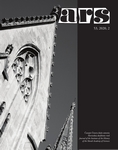
Časopis ARS 53 (2020) 2
Tim Juckes
A Tale of Two Churches: Court and Parish Projects at St. Stephen’s in Vienna
(Resumé)
Late medieval St. Stephen’s has often been viewed through the lens of Habsburg patronage and remains closely associated with a series of rulers, whose names have become synonymous with parts of the structure (“Albertinian” choir, “Rudolfinian” nave, etc.). The present article shifts the focus from the court to the role of the urban parish during the fourteenth- and fifteenth-century rebuilding of the church. Expanding on documentary evidence for an interruption to works after Rudolf IV’s early death in 1365, it shows that substantial parts of the new complex were constructed under the auspices of the burghers during later campaigns – with little input from the Habsburgs, and with little reverence for any long-standing Rudolfinian plans. These architectural findings are then related to the church’s cycles of integral sculpture from the same period, which show similar phenomena: on the one hand, important Rudolfinian works (such as the Fürstenfiguren, c. 1359-65) were later placed in unforeseen contexts following interventions by the burghers; on the other, new commissions (such as the numerous pier figures of the nave, mid-fifteenth century) were the product of patrician patronage and had still less to do with Rudolf ’s original intentions. In this way, St. Stephen’s is explored as a finely calibrated ensemble of visual media that arose from an idiosyncratic form of dual patronage: it was ultimately neither court nor city, but rather the interactions of the two groups that came to define the late medieval site.